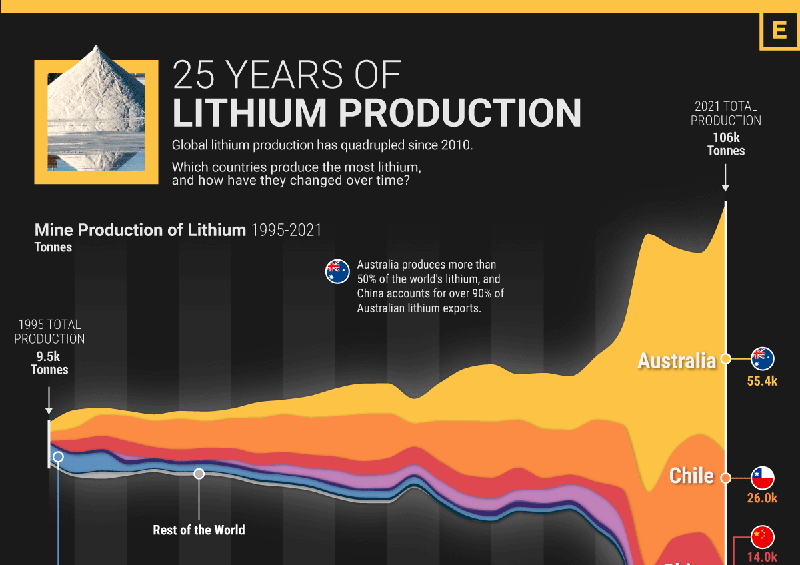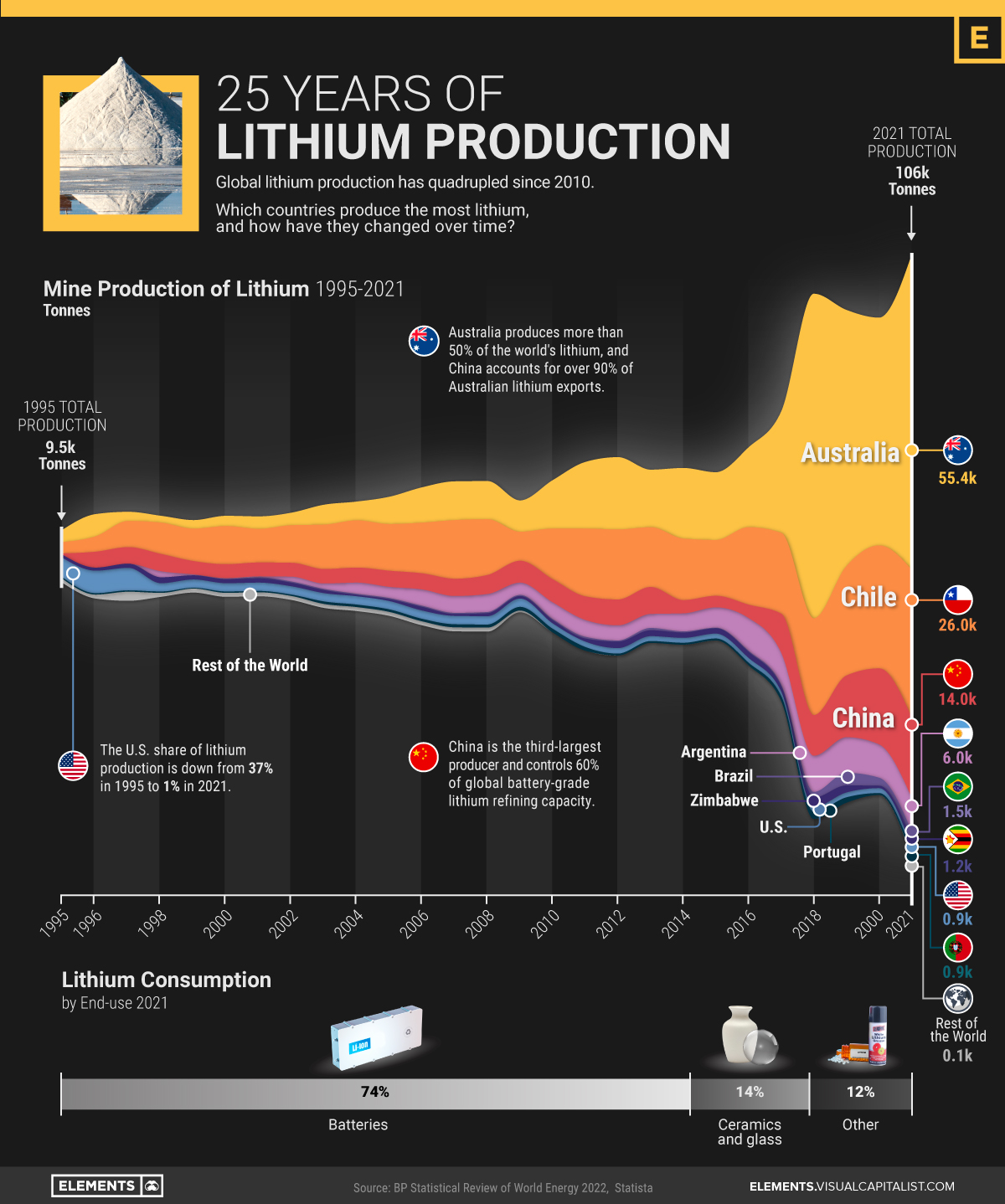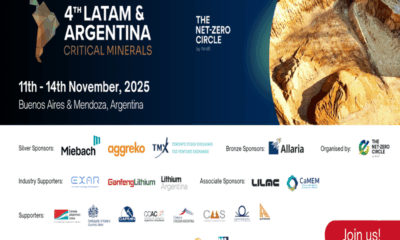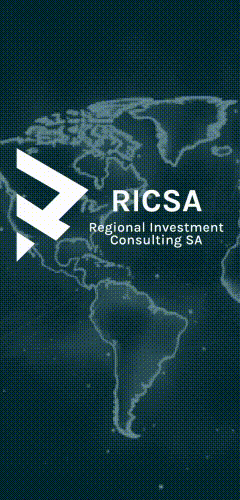litio internacional
Visualizing 25 Years of Lithium Production

#Lithium #Products #Mobility #ElectricVehicles #Electromobility #Litio
Lithium Production by Country (1995-2021).
Lithium is often dubbed as “white gold” for electric vehicles.
The lightweight metal plays a key role in the cathodes of all types of lithium-ion batteries that power EVs. Accordingly, the recent rise in EV adoption has sent lithium production to new highs.

The above infographic charts more than 25 years of lithium production by country from 1995 to 2021, based on data from BP’s Statistical Review of World Energy.
The Largest Lithium Producers Over Time
In the 1990s, the U.S. was the largest producer of lithium, in stark contrast to the present.
In fact, the U.S. accounted for over one-third of global lithium production in 1995. From then onwards until 2010, Chile took over as the biggest producer with a production boom in the Salar de Atacama, one of the world’s richest lithium brine deposits.
Global lithium production surpassed 100,000 tonnes for the first time in 2021, quadrupling from 2010. What’s more, roughly 90% of it came from just three countries.
Rank Country 2021 Production (tonnes) % of Total
#1 Australia 55,416 52%
#2 Chile 26,000 25%
#3 China 14,000 13%
#4 Argentina 5,967 6%
#5 Brazil 1,500 1%
#6 Zimbabwe 1,200 1%
#7 Portugal 900 1%
#8 United States 900 1%
Rest of World 102 0.1%
Total 105,984 100%
Australia alone produces 52% of the world’s lithium. Unlike Chile, where lithium is extracted from brines, Australian lithium comes from hard-rock mines for the mineral spodumene.
China, the third-largest producer, has a strong foothold in the lithium supply chain. Alongside developing domestic mines, Chinese companies have acquired around $5.6 billion worth of lithium assets in countries like Chile, Canada, and Australia over the last decade. It also hosts 60% of the world’s lithium refining capacity for batteries.
Batteries have been one of the primary drivers of the exponential increase in lithium production. But how much lithium do batteries use, and how much goes into other uses?
What is Lithium Used For?
While lithium is best known for its role in rechargeable batteries—and rightly so—it has many other important uses.
Before EVs and lithium-ion batteries transformed the demand for lithium, the metal’s end-uses looked completely different as compared to today.
End-use Lithium Consumption 2010 (%) Lithium Consumption 2021 (%)
Batteries 23% 74%
Ceramics and glass 31% 14%
Lubricating greases 10% 3%
Air treatment 5% 1%
Continuous casting 4% 2%
Other 27% 6%
Total 100% 100%
In 2010, ceramics and glass accounted for the largest share of lithium consumption at 31%. In ceramics and glassware, lithium carbonate increases strength and reduces thermal expansion, which is often essential for modern glass-ceramic cooktops.
Lithium is also used to make lubricant greases for the transport, steel, and aviation industries, along with other lesser-known uses.
The Future of Lithium Production
As the world produces more batteries and EVs, the demand for lithium is projected to reach 1.5 million tonnes of lithium carbonate equivalent (LCE) by 2025 and over 3 million tonnes by 2030.
For context, the world produced 540,000 tonnes of LCE in 2021. Based on the above demand projections, production needs to triple by 2025 and increase nearly six-fold by 2030.
Although supply has been on an exponential growth trajectory, it can take anywhere from six to more than 15 years for new lithium projects to come online. As a result, the lithium market is projected to be in a deficit for the next few years.
By Govind Bhutada
Graphics/Design: Sam Parker
Source: VisualCapitalist

litio internacional
SouthCross inaugura oficina en Chile y lanza una alianza estratégica con Alfa Logistics

#SouthCrossLogistic #Chile #Logistica #AlfaLogistics #AlfaSouthCross #LiNews
Buenos Aires / Santiago de Chile, 2025. SouthCross Logistics, operador logístico internacional con presencia en más de 9 países de Latinoamérica, continúa su plan de expansión regional con la apertura de una nueva oficina en Santiago de Chile. Esta decisión estratégica fortalece su cobertura en el Pacífico y consolida su posicionamiento como uno de los freight forwarders más relevantes de la región. (más…)
litio internacional
SouthCross inaugura oficina en Chile y lanza una alianza estratégica con Alfa Logistics

#SouthCrossLogistics #AlfaLogistics #Chile #Argentina #Latam #Logistica #LiNews
Buenos Aires / Santiago de Chile, 2025. SouthCross Logistics, operador logístico internacional con presencia en más de 9 países de Latinoamérica, continúa su plan de expansión regional con la apertura de una nueva oficina en Santiago de Chile. Esta decisión estratégica fortalece su cobertura en el Pacífico y consolida su posicionamiento como uno de los freight forwarders más relevantes de la región. (más…)
litio internacional
Histórica Alianza por el Futuro Energético: Fraunhofer Chile y Cámara Internacional del Litio (CIL) Unen Fuerzas por la Innovación Sustentable

#CamaraInternacionaldelLitio #Cil #Litio #Lithium #Chile #Fraunhofer #Mineria #Alemania
Con el firme propósito de acelerar la transición energética desde América Latina hacia el mundo, la Cámara Internacional del Litio (CIL) ha suscrito una alianza estratégica con Fraunhofer Chile, institución líder en investigación aplicada, vinculada al prestigioso instituto Fraunhofer de Alemania. (más…)




























